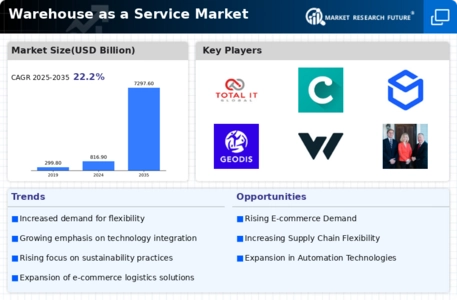Market Analysis
In-depth Analysis of Warehouse as a Service WaaS Market Industry Landscape
The Warehouse as a Service (WaaS) market is witnessing a surge in demand, primarily driven by the scarcity of space in eCommerce fulfillment centers. This scarcity has emerged as a significant catalyst as the eCommerce industry experiences rapid growth, necessitating efficient warehousing and fulfillment operations to keep pace with the increasing demands of online shopping and eCommerce platforms.
The expanding landscape of eCommerce, coupled with the rising popularity of online shopping, has resulted in an unprecedented demand for warehousing and fulfillment services. As more businesses venture into eCommerce and traditional retailers extend their online presence, the requirement for adequate storage space to manage inventory and facilitate seamless order fulfillment has reached unprecedented levels. The finite nature of warehouse space becomes particularly pronounced in sought-after locations near major urban centers and transportation hubs, intensifying the competition among businesses vying for these prime locations. Meeting customer expectations for swift shipping and delivery times further amplifies the pressure on companies to secure suitable warehouse facilities. This heightened competition and scarcity of available warehouse space have posed challenges for companies striving to support their eCommerce operations effectively, necessitating the adoption of Warehouse as a Service (WaaS) solutions.
Moreover, the financial constraints faced by end-users have become a pivotal factor influencing the growth of the WaaS market. Constructing and maintaining modern, technologically advanced fulfillment centers can be financially burdensome for businesses operating within limited budgets. Budgetary constraints often lead to resource limitations, making it challenging for businesses to optimize their warehousing and fulfillment operations. In response to these financial challenges, the adoption of WaaS solutions becomes a viable and pragmatic option, allowing businesses to leverage the benefits of advanced warehousing services without incurring prohibitive costs.
In essence, the scarcity of eCommerce fulfillment center space and budget constraints among end-users have emerged as driving forces behind the increasing demand for Warehouse as a Service (WaaS). As businesses strive to navigate the challenges posed by limited warehouse space and financial limitations, the adoption of WaaS solutions becomes instrumental in ensuring efficient and cost-effective warehousing and fulfillment operations in the dynamic landscape of the eCommerce industry.














Leave a Comment